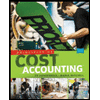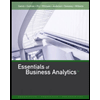
Concept explainers
1. a.
Compare the bid price for the job L and job E under simplified costing system.
1. a.
Explanation of Solution
Budgeted overhead allocation rate: The budgeted overhead allocation rate is the rate at which the overhead is allocated. This is calculated by dividing the total fixed and variable overheads cost by the base of the allocation.
Compare the bid price for the job L and job E under simplified costing system.
| Job L | Job E | |
| Professional labor cost: | ||
| 70 hours at $65 (1) | $4,550 | |
| 70 hours at $65 | $4,550 | |
| Professional support: | ||
| 70 hours at $70 (2) | 4,900 | |
| 70 hours at $70 | 4,900 | |
| Total cost | $9,450 | $9,450 |
| Markup on cost, 25% | 2,363 | 2,363 |
| Bid price | $11,813 | $11,813 |
Working Note (1):
Compute the cost of professional labor per hour.
Working Note (2):
Computed the cost of professional support per hour.
b.
Discuss whether the results seem reasonable.
b.
Explanation of Solution
The administrative support costs are driven by the Job L, and also Job L had many more expensive partner hours. Yet the two
2.
Compare the bid price for the job L and job E under activity-based costing system.
2.
Explanation of Solution
Compare the bid price for the job L and job E under activity-based costing system.
| Job L | Job E | |
| Partner labor cost: | ||
| 50 hours at $125 (3) | $6,250 | |
| 15 hours at $125 | $1,875 | |
| Associate labor cost: | ||
| 20 hours at $50 (4) | 1,000 | |
| 55 hours at $50 | 2,750 | |
| Legal support: | ||
| 70 hours at $50 (5) | 3,500 | |
| 70 hours at $50 | 3,500 | |
| Administrative support: | ||
| 50 hours at $100 (6) | 5,000 | |
| 15 hours at $100 | 1,500 | |
| Total cost | $15,750 | $9,625 |
| Markup on cost, 25% | 3,938 | 2,406 |
| Bid price | $19,688 | $12,031 |
Working Note (3):
Compute the cost of partner labor per hour.
Working Note (4):
Computed the cost of associate labor per hour.
Working Note (5):
Computed the cost of legal support per professional hour.
Working Note (6):
Computed the cost of staff support per partner hour.
3. a.
Compute the difference in bid price for each job between simplified costing system and activity-based costing system.
3. a.
Explanation of Solution
Calculate the difference between the bid price under simplified costing system and activity-based costing system.
| Job L | Job E | |
| Simplified costing | $11,813 | $11,813 |
| ABC costing | 19,688 | 12,031 |
| Difference | $(7,875) | $(218) |
b.
Identify whether the jobs were undercosted or overcosted, and also identify the job that had the greater differential with the reason behind it.
b.
Explanation of Solution
Using the simplified costing system, each of the two jobs was undercosted. Job E was undercosted by an insignificant amount of $218, whereas, the Job L was undercosted by a very significant amount of $7,875, as the litigation work was entailed by Job L, which had to be done primarily by partners. Without regard to whether associates’ hourly labor cost of $50 or partner hourly labor cost of $125 was being worked on a job, like peanut butter, the costs are equally spread by the simplified system over both jobs. Also, when compared to associates, more administrative support is more consumed by the partners.
Want to see more full solutions like this?
Chapter 9 Solutions
Principles of Cost Accounting
- Can you explain the correct methodology to solve this general accounting problem?arrow_forwardPlease provide the solution to this general accounting question with accurate financial calculations.arrow_forwardI need help with this general accounting question using standard accounting techniques.arrow_forward
- The Great Eastern TableGreat Eastern Table Company produces dining tables in a three-stage process: Sawing, Assembly, and Staining. Costs incurred in the Sawing Department during September are summarized as follows: Working in process inventory sawing. September 1 balance = 0Direct materials = 1,860,000Direct labor = 143,000Manufacturing overhead = 161,500Direct materials (lumber) are added at the beginning of the sawing process, while conversion costs are incurred evenly throughout the process. September activity in the Sawing Department included sawing of 13,000 meters of lumber, which were transferred to the Assembly Department. Also, work began on 2,000 meters of lumber, which on September 30 were 75% of the way through the sawing process.arrow_forwardBlack Oil Company is trying to decide whether to lease or buy a new computer-assisted drilling system for its extraction business. Management has already determined that acquisition of the system has a positive NPV. The system costs $9.4 million and qualifies for a 25% CCA rate. The equipment will have a $975,000 salvage value in five years. Black Oil’s tax rate is 36%, and the firm can borrow at 9%. Cape Town Company has offered to lease the drilling equipment to Black Oil for payments of $2.15 million per year. Cape Town’s policy is to require its lessees to make payments at the start of the year. Suppose it is estimated that the equipment will have no savage value at the end of the lease. What is the maximum lease payment acceptable to Black Oil now?arrow_forwardI need help with this general accounting question using the proper accounting approach.arrow_forward
- Space Exploration Technology Corporation (Space X), is an aerospace manufacturer that sells stock engine components and tests equipment for commercial space transportation. A new customer has placed an order for eight high-bypass turbine engines, which increase fuel economy. The variable cost is $1.6 million per unit, and the credit price is $1.725 million each. Credit is extended for one period, and based on historical experience, payment for about one out of every 200 such orders is never collected. The required return is 1.8% per period. Required Assuming that this is a one-time order, should it be filled? The customer will not buy if credit is not extended. What is the break-even probability of default in part 1? Suppose that customers who don’t default become repeat customers and place the same order every period forever. Further assume that repeat customers never default. Should the order be filled? What is the break-even probability of default?arrow_forwardCan you explain the correct methodology to solve this general accounting problem?arrow_forwardPlease help me solve this general accounting question using the right accounting principles.arrow_forward
- Suppose during 2025 that Federal Express reported the following information (in millions): net sales of $82,500 and net income of $185. Its balance sheet also showed total assets at the beginning of the year of $27,000 and total assets at the end of the year of $23,000. Calculate the asset turnover and return on assets. (Round answers to 2 decimal places, e.g. 6.25 or 6.25%.) Asset turnover Return on assets times %arrow_forwardThe shareholders of Barley Corporation have voted in favor of a buyout offer from Wheat Corporation. Information about each firm is given here: Barley Wheat Price/earnings ratio 13.5 21 Shares outstanding 90,000 210,000 Earnings $180,000 $810,000 Barley shareholders will receive one share of Wheat stock for every three shares they hold of Barley. Required What will the EPS of Wheat be after the merger? What will be the P/E ratio if the NPV of the acquisition is 0? What must Wheat feel is the value of the synergy between these two firms? Explain how your answer can be reconciled with the decision to go ahead with the takeover?arrow_forwardI am trying to find the accurate solution to this general accounting problem with the correct explanation.arrow_forward
 Principles of Cost AccountingAccountingISBN:9781305087408Author:Edward J. Vanderbeck, Maria R. MitchellPublisher:Cengage Learning
Principles of Cost AccountingAccountingISBN:9781305087408Author:Edward J. Vanderbeck, Maria R. MitchellPublisher:Cengage Learning Essentials of Business Analytics (MindTap Course ...StatisticsISBN:9781305627734Author:Jeffrey D. Camm, James J. Cochran, Michael J. Fry, Jeffrey W. Ohlmann, David R. AndersonPublisher:Cengage LearningPrinciples of Accounting Volume 2AccountingISBN:9781947172609Author:OpenStaxPublisher:OpenStax College
Essentials of Business Analytics (MindTap Course ...StatisticsISBN:9781305627734Author:Jeffrey D. Camm, James J. Cochran, Michael J. Fry, Jeffrey W. Ohlmann, David R. AndersonPublisher:Cengage LearningPrinciples of Accounting Volume 2AccountingISBN:9781947172609Author:OpenStaxPublisher:OpenStax College


